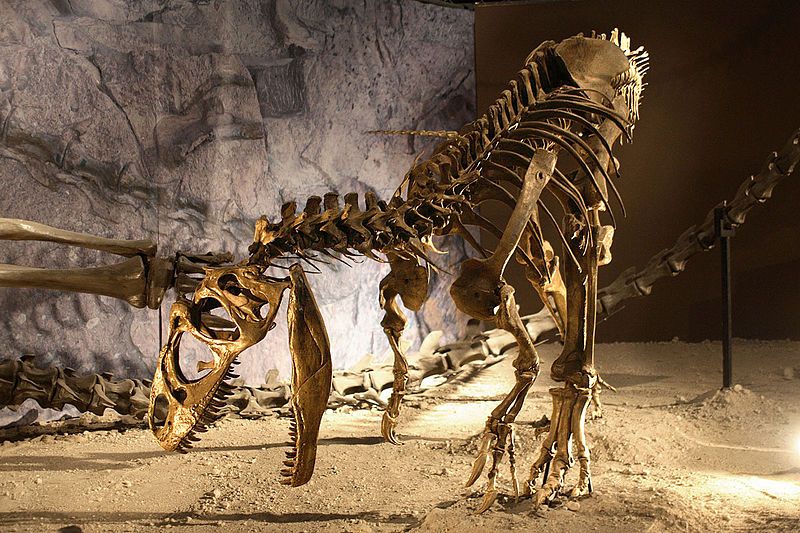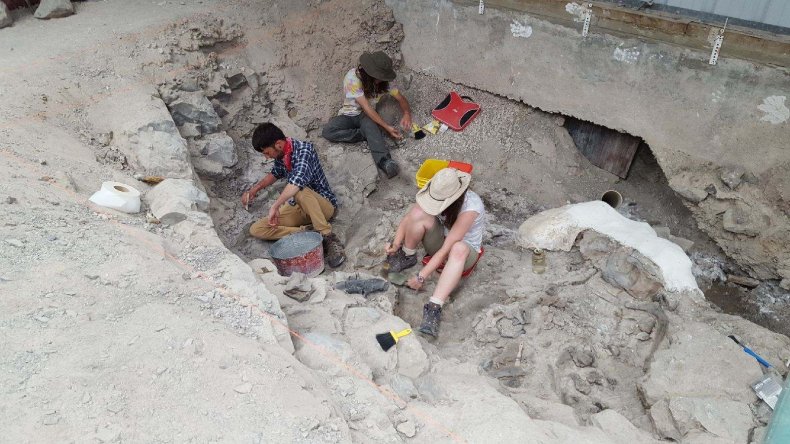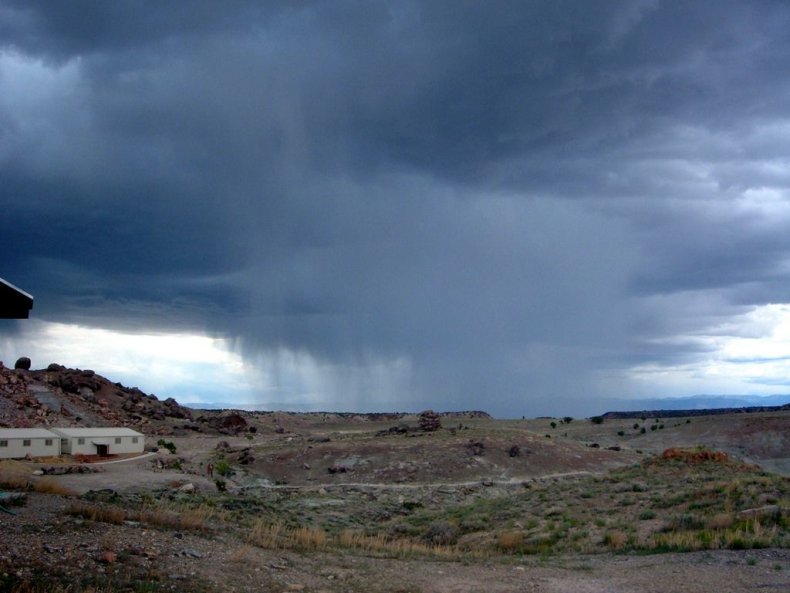
An Allosaurus fossil. The Cleveland fossil site has an unusually large proportion of Allosaurus fossils. Kabacchi/CC
Updated | Scientists have finally solved a 100-year-old mystery about a dinosaur graveyard in Cleveland, Utah.
The Cleveland-Lloyd Dinosaur Quarry (CLDQ) was first discovered in the 1920s and excavations soon showed it was the densest deposit of Jurassic theropod dinosaurs ever found. They also showed the fossil bed had an unusually large proportion of Allosaurus fossils—a 28- feet-long predatory dinosaur that lived in North America 155 to 150 million years ago.
The question of how so many dinosaurs ended up in such a small area has baffled scientists ever since. Some theories suggest there was a catastrophic event—potentially the dinosaurs were poisoned, died in a severe drought, or became trapped in the thick mud that would have been present at the site.
Another idea is that the site represents numerous events that would have brought dinosaurs to the site, either alive or dead, over different periods of time.

In a study published in the journal PeerJ, a team of U.S. researchers tried to reach a consensus about how the fossils ended up at the CLDQ by analyzing the processes that affected the remains as they were fossilized. As well as looking at the dinosaur fossils, the team examined the minerals in the sediments to better understand the environment of the period.
This allowed them to develop a reconstruction showing the history of the deposits.
Study author Jonathan Warnock, from the Indiana University of Pennsylvania, tells Newsweek that before they began their research they did not know which result—evidence of single or multiple death events—to expect.
Their findings showed the dinosaurs accumulated at the site over several different periods, with carcasses being transported there during flooding events. When floods came, the dinosaurs would have washed in and rotted in what was then a pond.
These rotting bodies would have created an environment unsuitable for fish and crocodiles, which explains the lack of these fossils at the site. Nor would other dinosaurs have eaten the carcasses, which is why bite marks are not present on the fossils.
“We are finding some consensus among the many hypotheses surrounding CLDQ,” Warnock says. “So many ideas have been put forward to explain CLDQ, each with its own problems. We have found evidence for flood, drought and bloat-and-float as well as toxicity of a sort. In order to interpret Jurassic paleoecology from this deposit, consensus is key.”

Excavation work at the Cleveland-Lloyd Dinosaur Quarry. Joe Peterson
However, he says their work is not conclusive and there is still far more research to be done at the site: “This is our first work at CLDQ, and many of our hypotheses have alternatives. We are going to be expanding our sample sets for geochemistry, as well as adding in rare earth element and isotopic analyses.”
He said they plan to look more closely at the layers of the fossil remains to put their findings into context. They also want to look at algae fossils and to analyze sites away from the quarry to compare the environments.
But another big mystery remains. Why were there so many fossils of the Allosaurus, a large therapod dinosaur? “That’s still the $1,000,000 question!” Warnock says. “We are looking at future research to determine whether or not the Allosaurus died together and were washed in or represent individuals brought in from across a landscape.”
He says it could be because there were a lot of smaller predators like Allosaurus in relation to fewer, but far larger herbivores, like sauropods: “[This] might have been the Jurassic norm. We hope to be able to understand Jurassic population dynamics.”

They also need to better understand the size of the floods. This will help them find out if snapshot dinosaur population had washed into the pond, or if a smaller flood brought in a comparatively larger number of Allosaurus. To work this out, researchers plan to look at the energy required to move the bone fragments and pebbles.
“The density of bones at CLDQ likely reflects the biomass, live and recently dead, available to be washed into this small pond during the flood season,” Warnock says. “Looking at other Morrison Formation quarries, we see that very dense bone beds are not uncommon. The question really is why so many Allosaurus are here, compared to so many herbivores elsewhere. As for that, stay tuned.”
In previous research, Terry Gates, from North Carolina State University, said the dinosaurs at the CLDQ appeared to have died as a result of drought. Commenting on the latest study, he tells Newsweek: “The Cleveland-Lloyd Dinosaur Quarry has drawn a great deal of attention for nearly 100 years because it defies every expectation of what should be found in a dinosaur quarry. There are at least 49 carnivorous dinosaurs called Allosaurus within this ancient deposit.
“Most of the paleo-detective work to date has focused on the detail of the large number of carnivorous dinosaurs, trying to explain the disproportional number; however, my work, over 10 years ago, and now the new study looks at the CLDQ as a mystery of how over 75 dinosaurs ended up becoming buried in one small location 147 million years ago.”

The Cleveland-Lloyd Dinosaur Quarry. Horatio3K/Flickr
He said the study of “prehistoric forensics” is an excellent way to understand what happened at the site. In the latest research, the team looked at bone fragments that are “barely recognizable as bone.”
“Peterson’s new study is innovative because it focuses on parts of the bone deposit that largely have been overlooked for a hundred years,” he says. “Indeed, the information Peterson received from chemical analyses of the bone fragments tell us that the place where the dinosaurs were buried was likely a pond that dried up every year like we see on the African savannah. They are also suggest that the bones arrived at the quarry through annual flood events.

“This interpretation of how the bones arrived at the quarry is in contrast to my prior work suggesting droughts congregated dinosaurs to the site. The chemical data support both the drought hypothesis and the newly proposed flood hypothesis, leaving us with more information on the nature of the environment, but still on a scientific quest to discover what happened to these dinosaurs so long ago.”